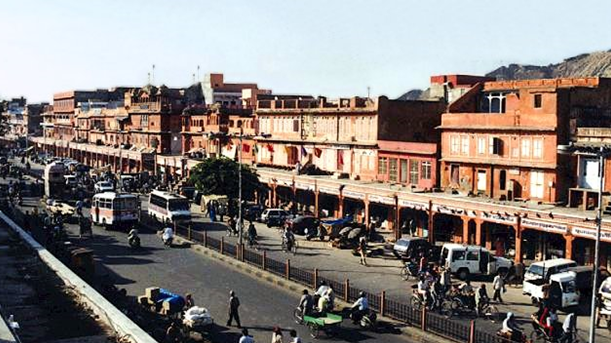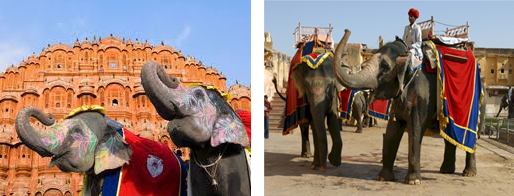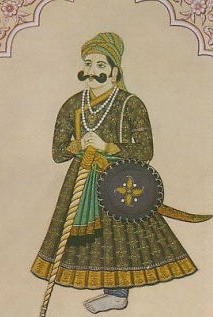Sri Govindaji was originally installed nearly 5,000 years ago by Lord Krishna’s great-grandson. Govindaji is one of the four presiding Deities of Braja-mandala (greater Vrindavan). This temple is located right next to the city palace within the innermost walls of the old city. Govindaji was originally worshiped by Srila Rupa Goswami and installed at the Radha Govindaji Temple in Vrindavan. Govindaji was later brought to the city of Amber, near Jaipur, by Maharaja Jai Singh II to protect the Deity from destruction at the hands of the Muslim emperor Aurangzeb. Jai Singh’s grandfather had originally constructed the Govindaji Temple in Vrindavan. Govindaji was moved to the present temple in Jaipur about 1728. Maharaja Jai Singh created his “City of Victory,” the city of Jaipur, as a dedication to Lord Govindaji. The temple is in a garden of the palace complex, and when the temple doors were opened, Maharaja Jai Singh in the past could see his beloved Deity from the royal quarters. On the altar are full-sized Deities of Govindaji, a beautiful black marble Deity, and Radha Rani.

The deity of Radha Rani as the saying goes, was earlier in Vrindavan and known as one of the incarnations of divine goddess shakti. For the reasons of security from the growing danger of yavanas, a brahamin named “Brihadbhanu” took the deity to Radhanagar in Orissa. After the death of Brihadbhanu, The King of Orissa, Prataprudra established the deity in a place called Chakravedha in Puri where it gained fame as “Laxmi Thakurani”. After Prataprudra, when king Purushottam of Orrisa (Son of Prataprudra) learned about the appearance of the deity of Lord Vrindavan, he sent this deity which actually was of Radha Rani, to Vrindavan. He arranged the marriage of Radha Rani with Lord Govind Devji with a lot of pomp in samvat 1690 (The year 1633); and Radha Rani’s deity was placed to the left of Lord Govind Devji.
The news of manifestation of Lord Govindaji to Rupa Goswami was immediately sent toChaitanya Mahaprabhu in Nilachal at Orrissa so that He could come to Vrindavan. Mahaprabhu made a small deity of eight metals (Ashtadhatu) depicting himself for the purpose of giving ‘Darshana’ and injected his divine power into the deity. He sent this deity of him with his closely trusted & beloved Shriman Kashishwar Pandit to Vrindavan. The deity was placed on the right of Lord Govind Devji. It gained the name of Shri Gaur Govinda. Behind the temple is a large garden. Mangala-arati draws about 5,000 people a day. It is an absolute must to attend. The devotees enthusiastically chant prayers in praise of Lord Govindaji. The translation to the mantra that is chanted in front of Govindaji is: “We are hunger for the sight of your face, and we wish to fix you constantly in our thoughts while meditating on your lotus face. This life is full of responsibilities and now we are in the middle of the ocean, please give us your blessing so that we can relieve ourselves of life’s burdens and understand the meaning of life.”
Inclusion of sakhis:
On Asoj Budi 11, Samwat 1784 (Hindi Month) -the year1727, the deity of Vishakha was offered by Maharaja Jai Singh II of Jaipur for Itra seva (offering Perfume ) and placed on the left side of Radha Govind Devji. Afterwards in Samwat 1858 -the year 1801, Maharaja Sawai Pratap Singh offered the deity of Lalita for Tambul Sewa (offering beetle leaves). The deity was placed on the right side of Radha Govind Devji.
Journey of Govinda Deva
In the year 1669 A.D., during the reign of Aurangzeb when religious fanaticism was at its height, Shri Shiva Ram Goswami, the then Sewadhikari of Lord Govind Devji, shifted the deities. First he shifted to Kamyavana (where it remained for 33 years) via Barsana, Radhakund and then to Govindpura Village (Ropara) in 1707 making divine stay at Govindgarh & Khawa (Jamwaramgarh).Thereafter, the deities reached Kanaka Vrindavan (in Amber valley) and were subsequently taken uphill to Jai nivas (Amber palace). Finally, the deities were installed in the “Suraj Mahal” of the city palace (the present temple) in Jai Niwas Gardens.
Arati Timings
During Kartika (Oct-Nov) arati times are 5am , 8am , 10am , 11.30 am and 5.15pm , 6.15 pm and 8.15 pm. Every month, arati time changes


